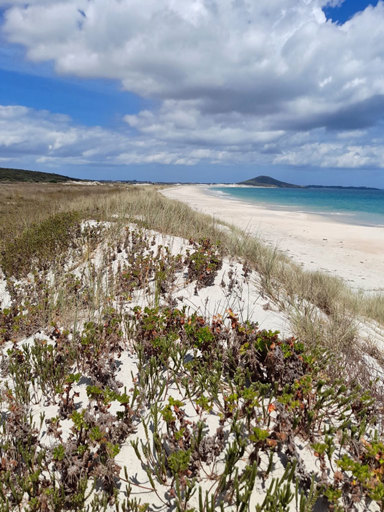Story
Garden plants in the dunes
Sand dunes and coastal areas can be particularly vulnerable to invasion by non-native species. Invasive plants can spread easily through dumping of garden waste on the dunes, or accidental transfer of seeds or root fragments.

Pelargonium, growing in the dunes at Karikari.
In some coastal areas people have also tried to stabilise the dunes, or to change their appearance, by introducing non-native species.
These species are often well-adapted to coastal conditions and crowd out native dune plants, leading to loss of protective function and biodiversity values. Problem species include agapanthus, wattle (acacia), exotic iceplant and exotic grasses like kikuyu and buffalo grass.
Other plants that are a problem in our dunes spread from gardens. They are often attractive and popular because they are very hardy.
These include the pelargonium family, known commonly as geraniums. These plants are garden favourites due to their attractive, bright-coloured flowers and hardy nature. There are several popular varieties, including rose and lemon scented. They are well-adapted to coastal environments, preferring free-draining soil and plenty of sunshine.
It can be tricky to tell the different pelargonium species apart from each other and they can hybridize, or cross-breed.
The rose-scented geranium (Pelargonium capitatum) can rapidly colonise dune areas, pushing out native species.
Geraniums can spread by both seed and root fragments, and seed dispersal can be by wind, water or movement of soil.
There are also a number of bulbs which are invading dune areas. These include wild gladioli, watsonia and monbretia. Wild gladiolus (Gladiolus undulatus) grows up to 1.4m high, with tapering white or cream-coloured flowers, though it often doesn’t flower in the wild form. It re-grows each year from underground cormils or bulbs that can spread through dumping of garden waste, transfer on tyres and in water.
Wild gladiolus was introduced as an ornamental in Australia and is now recognised there as an invasive pest.
These plants may be lovely to look at in gardens, but it’s vital they don’t gain a foothold in Te Taitokerau’s fragile dune ecosystems.
How you can help:
We can all help fight the spread of pest plants. Many pest plants are garden escapees – you can do your bit by:
- Composting garden waste instead of dumping it onto the dunes.
- Keeping lawn clippings and other plant cuttings off the dunes.
- Removing invasive introduced plants and replacing them with natives.
- Keeping to tracks to keep native dune plants healthy.
- Set up a weed control project with your local CoastCare group. Contact us for support and guidance email: coastcare@nrc.govt.nz
You can also share your whakaaro on how invasive plants and animals are managed in Te Taitokerau by contributing to NRC’s review of the Pest Plan. Find out more and how to contribute at: www.nrc.govt.nz/pestplan
It can be challenging to identify some plant species, but you can check which species you’ve found and log sightings at iNaturalist: www.inaturalist.org





